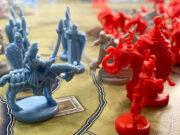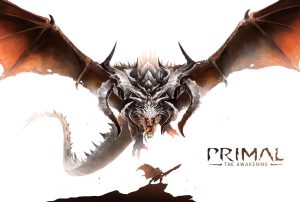 Primal: The Awakening seemed like a risky crowdfunding campaign to back. It was only Reggie Games second game. It was heavy on plastic, expensive, and scheduled to be delivered in the middle of a pandemic.
Primal: The Awakening seemed like a risky crowdfunding campaign to back. It was only Reggie Games second game. It was heavy on plastic, expensive, and scheduled to be delivered in the middle of a pandemic.
The game, although two years late, was delivered to its backers. It was received well, earning a BGG ranking 8.6. of It is also now available from their webstore. Should you jump online and purchase this behemoth to celebrate the start of 2025? Or should you save you money for the next expensive crowdfunded campaign?
Gameplay Overview:
Primal: The Awakening is a card-driven, cooperative boss battler for one to four hunters. There are two ways to play the game. You can play campaign mode, made up of 12 battles against huge creatures, with both the monsters and the players getting more powerful as you play more.
You can also play in expedition mode, a one-shot battle against the monster you choose. Regardless of the mode, fights take between one and two hours, with experience with the game, and lower player counts, reducing the time needed per fight.
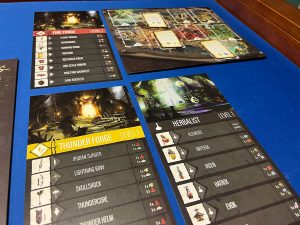
Fights last up to ten rounds. Each round is divided into four steps:
- Consume
- Players decide if they want to consume one of their potions.
- Monster Upkeep
- Behavior refresh – the monster’s behavior card with the lowest refresh is discarded and replaced with a new behavior card.
- Add one struggle for each hunter – Struggle boosts behavior cards or triggers unleash, which damages all hunters when struggle is equal to or greater than three times the number of hunters.
- Player Turns – the player with the aggro token is the first player. After the first player completes their turn, the next player in clockwise order completes their turn, repeating until all hunters have gone. A player’s turn consists of the following phases:
- Movement – Hunter decides to move one sector for one stamina or remain and become threatened (this can trigger behaviors or risk more damage during the attrition phase)
- Play cards/activate an ability/revive
- Attrition – Hunter potentially takes damage from the monster
- End of Turn – Discard played cards, refill hand, and the monster turns toward the player with the aggro token
- End of Round
Notice I did not cover any monster actions. That is because their behaviors are triggered by player actions. More on this in a bit.
The battle ends when the monster is defeated, all hunters are KOed, or the 10th round is completed without defeating the monster.
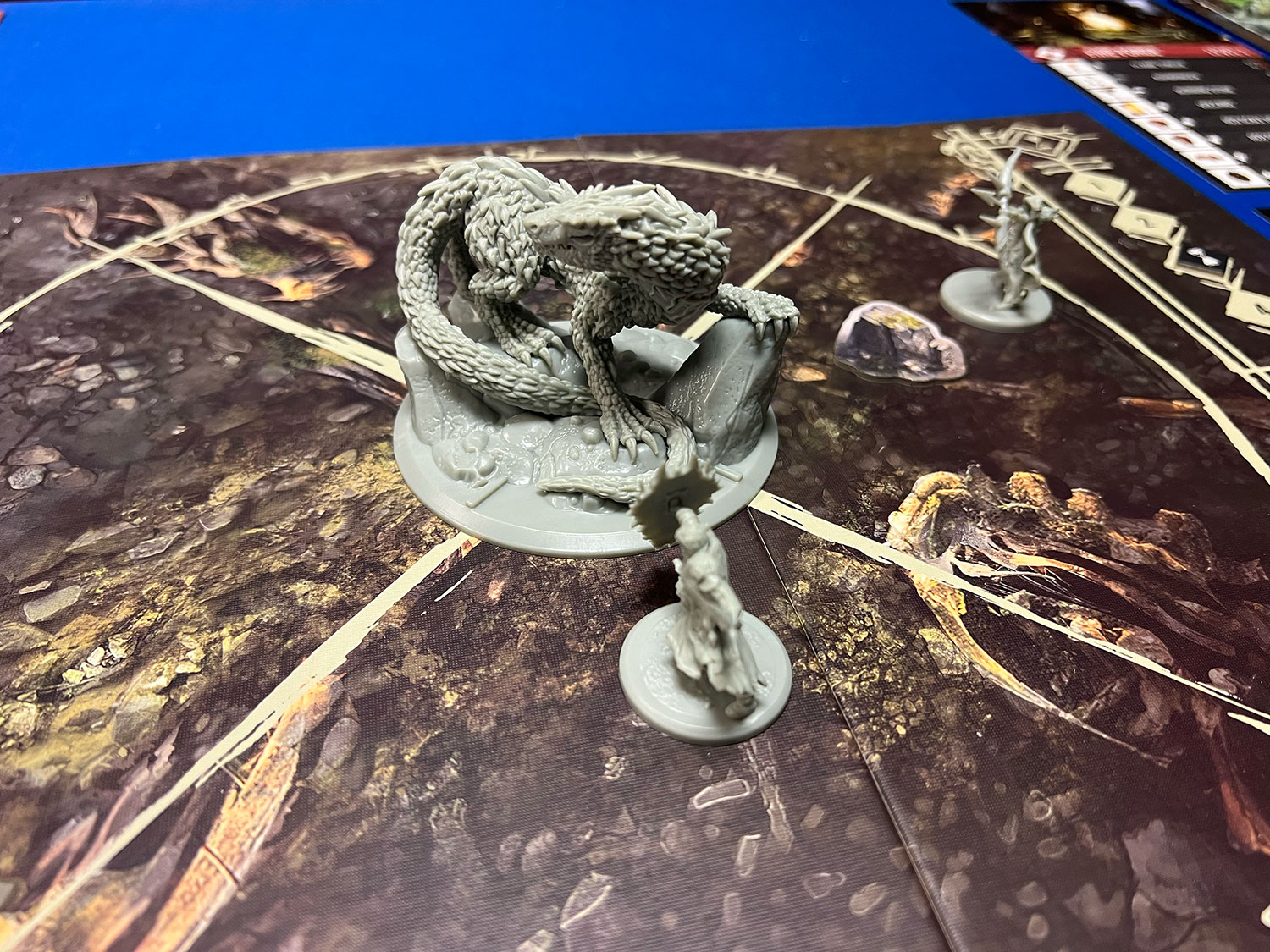
Game Experience:
What made me want to grab a blade and hunt oversized monsters IRL:
The card play in Primal is fantastic. Players have four types of cards available to them: two offensive, with red (attack) cards causing damage and blue (maneuver) cards reducing the monster’s struggle, and two defensive, with green (dodge) and yellow (parry) reducing the potential attrition damage taken that turn.
Cards are played into your sequence by paying their stamina cost with other cards – yes, they are multi-use. Deciding if you should play a card for its ability text and effect based on its color, or to pay for other cards, can be agonizing. You also need to consider the order you play your cards into your sequence. Some cards have effects that are activated if played after certain cards, with others setting up the card after them. Each monster also has an objective that can trigger based on a combination of cards played in a sequence. As you can see, you have many ways to utilize your cards and create combos to maximize your turn. It is a great card-driven system!
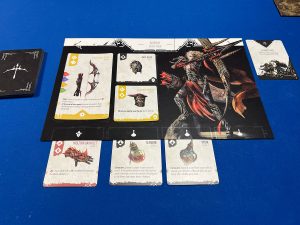
The game design also encourages cooperation. It is important to work together to best position the monster. Every monster has a set of stance cards that determine which of its four zones (front, rear, and two flanks) are vulnerable. Playing an aggro-generating card will force the monster to face you at the end of your turn. This may help your teammates, as they may be across from you, and now the monsters flank is in front of them because you grabbed aggro.
You also want to work together when you want, and do not want, to trigger monster behaviors (seriously, I will get to this in two more paragraphs. I promise). There are also cards with the keyword assist that allow you to play it when you are not the active player to allow the active player to draw a card. This can make it easier for your partner to pull of a combo in their Sequence.
Finally, there are other cards that let you help your teammates with different effects when discarded, like reducing incoming damage, or allowing other players to heal or draw cards when you play the card. Primal’s design excels at creating opportunities for impactful, cooperative decision-making.
I also prefer playing the campaign instead of the one-shot expeditions. The campaign story is okay. Reggie Games tried to build a compelling story, but it is told from the viewpoint of an observer, not the actual hunters. By the third fight, I found myself caring less about the story and more about which quest to pick (this dictates the monster you fight) and what loot to craft or card upgrades to choose after a successful mission. And this is ok with me. It lets me focus on the fun of making builds for the next battle, instead of reading pages of text. Hunt. Loot. Repeat. Watching your hunter grow, fighting more powerful monsters, or a monster you already fought with new behaviors, is the heart of the game and when it is at its best.
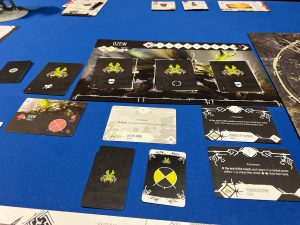 Finally, designing the monsters to not have their own turn, but instead acting when certain triggers are met, really creates a unique dance during every battle. Four behavior cards are face down, three on the monster dashboard and one on top of the behavior deck, with their back showing what action will trigger that card to be played. There are some downsides (see below), but knowing what actions will cause a response creates an interesting dilemma. Do you adjust your plans based on the triggers or determine the risk is worth the reward and still play cards that will cause triggers? I really enjoy this balancing act and it is one of the reasons I love this game.
Finally, designing the monsters to not have their own turn, but instead acting when certain triggers are met, really creates a unique dance during every battle. Four behavior cards are face down, three on the monster dashboard and one on top of the behavior deck, with their back showing what action will trigger that card to be played. There are some downsides (see below), but knowing what actions will cause a response creates an interesting dilemma. Do you adjust your plans based on the triggers or determine the risk is worth the reward and still play cards that will cause triggers? I really enjoy this balancing act and it is one of the reasons I love this game.
What made me cower behind my wife as she killed a spider in the corner of the room:
The biggest drawback and barrier to entry is the cost of the game. The cheapest I could find the game was around $250. That is for the core game only. If the game used standees instead of minis for the monsters, the game would have been much more affordable; however, its table presence would not be as stunning. The question you have to ask yourself is “Do you want to pay $250+ for giant miniatures that essentially sit and spin on a board?”
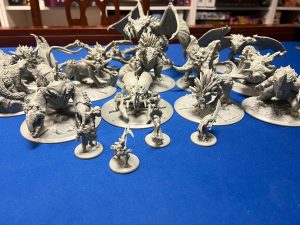
Beyond the cost of the game, I only had two gameplay-related issues with the game. The biggest issue is how fiddly the game can be. You must track which monster behaviors your actions may trigger, if there is a rampage behavior trigger (which causes it to trigger immediately after another trigger is…triggered), or if there are start of turn or end of round triggers. Yes, that is a lot to track. In fact, there are 24 different behavioral triggers. This does not count the triggers on stance cards, as well as environmental modifiers, buffs and debuffs on hunters and the monsters. Is it insurmountable? No. But be warned that there is a lot of tracking that needs to be handled.
That tracking is made easier with other players; however, in my opinion, this game shines at two players. It is the perfect balance of having someone to help with the bookkeeping, while including an additional player with whom you can discuss strategies. Once you get to three, or worse, four players, not only do the games take longer, but the number of behavioral triggers that occur between the end of your turn and the start of your next turn can drastically change the board state. This can cause your turn to be wasted and any plans you were forming to be made moot as you deal with the problems your idiot teammates created during their turns. These board state fluctuations are much more manageable at two players. I would not recommend this game for three or more players.
Final Thoughts:
I truly enjoyed Primal: The Awakening. In fact, I enjoyed It more than I thought I would. I did not think I would like the monster sitting in the middle of the board and rotating. I ended up loving it! It was simple but still provided strategic decisions. There are “only” four hunters. In reality, they are so different and have multiple builds available between their cards and weapons that I did not grow bored playing them repeatedly. Everyone I taught this game has enjoyed it. The hunters are fun to play, the card interactions are fun, the monsters are unique, and playing the game is a treat.
Final Score: 4.5 Stars – An excellent cooperative boss battler with dynamic combat
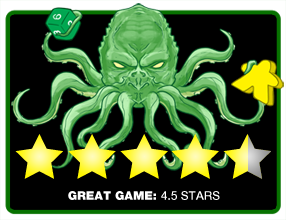 Hits:
Hits:
• Card play
• Gameplay driven cooperation
• Fun campaign
• Monster behaviors
Misses:
• Expensive
• Many modifiers and triggers to track
• Not as fun with three or four players




